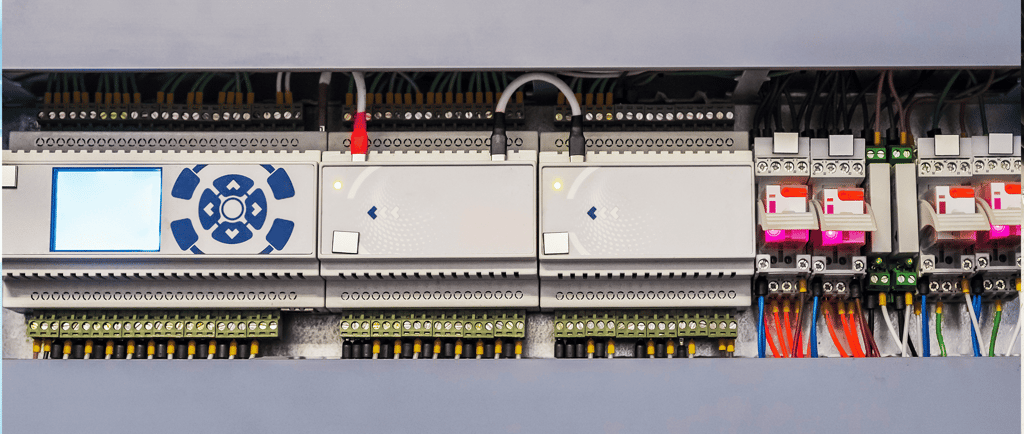Control Board Diagnostics: Common Fault Codes and How to Interpret Them
Discover how HVAC control boards relay vital system information through fault codes. Learn to decode common errors and keep your air-conditioning system running smoothly.
HVAC
3/17/20258 min read


Having a modern heating and cooling system isn’t just about compressors, fans, and refrigerant lines—it’s also about the control board (often called a circuit board or motherboard) that orchestrates every operation behind the scenes. This electronic component acts as your HVAC system’s “brain,” managing everything from startup sequences to safety checks. When problems arise, the control board typically displays fault codes that can shed light on what’s wrong, helping you or a technician address the issue faster.
This blog covers some of the most common control board fault codes you’ll encounter, offering guidance on how to interpret them. For homeowners, a basic understanding of these codes can help you troubleshoot minor hiccups or know what to mention when calling a professional. For HVAC professionals, deciphering fault codes accurately is a cornerstone skill—one that ensures quick diagnoses and less downtime for the property owner.
Why Control Boards Display Fault Codes
At the heart of nearly every modern furnace, air handler, or heat pump lies a control board programmed to carry out operating cycles. By monitoring various inputs—thermostat signals, limit switches, pressure switches, flame sensors, and more—the board makes decisions about when to ignite a burner, start a fan, or shut off the system to prevent damage.
When any sensor or component behaves outside its normal range, the control board logs an error or fault code. These codes usually appear as flashing LEDs (light-emitting diodes) on the board itself or as text on a digital display. They’re designed to streamline troubleshooting by pointing technicians to the suspect component or condition, saving valuable time compared to chasing random symptoms.
In essence, if your HVAC system is acting strangely—short cycling, failing to start, not producing conditioned air, or shutting down mid-cycle—a quick look at the control board’s indicator lights or display can reveal which subsystem is tripping a fault. That’s far more efficient than guessing blindly or tearing into unrelated parts.
Common Fault Codes and Their Meanings
Below are some of the most frequently encountered codes across various HVAC brands. Remember that each manufacturer might label codes slightly differently; code “31” on one board could be “Pressure Switch Fault,” while another brand uses “E2” for the same issue. Always refer to the specific unit’s manual for exact guidance. Still, these broad categories appear consistently across many systems.
1. Pressure Switch Errors (e.g., “Error Code 31,” “PS Error,” “PRESS SW OPEN”)
What It Means
Pressure switches monitor air pressure in the burner or combustion chamber. In systems with induced draft motors, the switch ensures enough airflow to expel combustion gases. If the board sees the switch open (or not closing properly) when it expects otherwise, it logs this fault.
Possible Causes
Blocked vent or flue pipe
Damaged or clogged inducer motor
Cracked or disconnected pressure switch tubing
Defective pressure switch itself
Typical Remedies
Check venting for obstructions or accumulated debris.
Inspect or test the inducer motor’s amperage; ensure it spins freely.
Verify tubing connections; look for cracks or moisture buildup.
If all else is fine, a failing pressure switch might require replacement.
2. Ignition/Flame Sensor Faults (“Error Code 34,” “Ign Lockout,” “Flame Sensor Fail”)
What It Means
In a furnace or heat pump with gas heat, the ignition control sequence must detect a flame within a set time after igniting the burners. If the flame sensor doesn’t register flame presence, or if ignition never occurs, the board halts the process to avoid dumping gas. This code might indicate ignition failure or a sensor reading error.
Possible Causes
Dirty or corroded flame sensor
Igniter not receiving power (hot surface igniter or spark igniter failure)
Gas valve malfunction or restricted gas flow
Loose wiring or poor ground reference
Typical Remedies
Gently clean the flame sensor with fine grit sandpaper or steel wool.
Check igniter continuity with a multimeter; if open, replace.
Confirm the gas valve coil receives voltage and opens fully.
Ensure the system’s grounding is solid—poor grounding can skew sensor readings.
3. Limit Switch or Rollout Switch Issues (“Code 33,” “Limit Circuit Open,” “Rollout Error”)
What It Means
A limit switch stops the furnace if temperatures exceed safe limits in the heat exchanger or blower compartment. Rollout switches trip if flames roll out of the burner area, often signaling a blocked heat exchanger or flue. These codes warn of a potential fire hazard or system overheat.
Possible Causes
Restricted airflow (clogged filters, blocked vents) leading to high furnace temperatures
Failure in the blower motor or belt (if applicable)
Cracked heat exchanger causing flame rollout
Blocked exhaust vent leading to incomplete combustion
Typical Remedies
Replace or clean air filters; remove any vent blockages.
Check blower motor operation or belt tension.
If rollout is suspected, thoroughly inspect the heat exchanger.
Verify exhaust pathways; ensure no obstructions impede flue gases.
4. High-Pressure Switch Trip or Low-Pressure Trip (“HP Switch,” “LP Switch,” “Error 21,” etc.)
What It Means
In air-conditioning or heat pump modes, the refrigerant circuit includes high- and low-pressure switches for system protection. A high-pressure switch opens if refrigerant pressure climbs too high, preventing damage to the compressor. A low-pressure switch opens if system pressure is too low, possibly due to a refrigerant leak or restricted flow.
Possible Causes
High-pressure fault: Dirty condenser coil, blocked airflow, overcharged refrigerant, or failing condenser fan
Low-pressure fault: Refrigerant leak, clogged evaporator coil, undercharging, or a failing metering device
Typical Remedies
Clean coils, check condenser fan operation, confirm correct refrigerant charge.
Use a manifold gauge set to measure suction and discharge pressures.
Inspect for oil stains or leaks around fittings, verifying no active leaks.
Clear any blockages in filters, strainers, or the expansion valve.
5. Communication or Thermostat Errors (“Comms Error,” “E1,” “L6,” etc.)
What It Means
Some modern systems use digital communication between control boards and thermostats, often on proprietary networks or protocols. If the board loses contact with the thermostat or sees corrupted signals, it logs a communication fault.
Possible Causes
Damaged or loose control wiring
Thermostat compatibility issues or firmware bugs
Electrical interference (from nearby power lines, motors)
Faulty thermostat or control board
Typical Remedies
Re-seat wiring connections, ensuring no corrosion or breaks.
Check if the thermostat’s software is up-to-date (some smart thermostats require firmware updates).
Move or shield cables from high-voltage lines that cause interference.
Substitute a known-good thermostat or temporarily bypass it to see if the error persists.
6. Blower Motor or Inducer Motor Faults (“Error Code 13,” “Motor Lock,” “Inducer Fault”)
What It Means
The control board monitors motor speed, current draw, and safety circuits linked to blower or inducer motors. A lockout code indicates the motor failed to spin up or is drawing excessive amps.
Possible Causes
Seized motor bearings or blocked wheel
Motor windings shorted or open
Capacitor failure (for PSC motors)
Voltage supply issues (brownouts, loose neutral)
Typical Remedies
Spin the fan or inducer wheel by hand to check for mechanical restriction.
Measure motor winding resistance and capacitor integrity with a multimeter.
Confirm the motor receives correct line voltage (often 120V or 240V).
Verify that no secondary controls (like a pressure switch or safety circuit) are locking out the motor.
Interpreting Blinking LEDs and Displays
Various manufacturers have different ways of displaying codes. You might see:
Steady Blinks: Some boards blink slowly for one digit, pause, then blink again for the next digit (e.g., 3 blinks, pause, 2 blinks, representing “Error 32”).
Fast Blinks: Rapid blinking patterns, possibly two sequences repeated.
Alphanumeric Display: A small screen might read “E1,” “F2,” “Err 31,” or “Ign Lk.”
When you spot these codes:
Check the Unit’s Manual: Look up how to decode the blinking sequence.
Record the Code: Snap a photo or note the pattern accurately.
Reset the System Only if Safe: Power cycling might clear temporary errors but if the root cause persists, the code will return.
Basic Troubleshooting Steps
While some issues demand a certified technician, you can address minor problems or gather key details before calling for service:
Confirm Power: Ensure your HVAC’s breaker hasn’t tripped, and any switches near the unit are on.
Inspect Air Filters: Blocked airflow is a common culprit for limit switch and high-pressure errors. Replace or clean filters if they’re dirty.
Check Thermostat Settings: Is it calling for cool/heat properly? A misconfiguration or low batteries can cause communication or ignition issues.
Look for Obvious Blockages: Dust or debris around the outdoor unit can hamper airflow, raising system pressures. Inducer vents can clog.
Write Down the Fault Code: If the control board LED blinks out a code, note it meticulously. That detail often saves time for a technician.
Advanced Diagnostics for Professionals
For HVAC professionals, beyond referencing manuals:
Multimeter Tests: Measure voltage across the board’s input and output terminals. For instance, if the board calls for ignition, see if 24V is reaching the gas valve coil.
Continuity Checks: Wires leading to safety switches or sensors should read closed circuits unless the system has intentionally opened them (like in high temperature conditions).
Schematic Familiarity: Quick reading of the system’s wiring diagram helps confirm which relay or switch the control board energizes in each step.
Firmware Updates (On Some Modern Boards): Smart systems with microprocessor boards might allow firmware flashes. Rare, but could resolve known bugs if the manufacturer provides updated software.
Properly addressing fault codes typically requires an organized approach: isolate the subsystem indicated by the code, confirm no mechanical obstructions, measure electrical continuity or voltage, then rule in or out potential failures. If multiple codes appear in sequence, identify which triggered first. Sometimes subsequent codes are secondary to an initial fault (e.g., a high-limit code triggers, then the board logs ignition errors as the system fails to restart).
Safety Considerations
HVAC control boards deal with high voltage (120V/240V) for blowers, plus 24V control circuits for sensors. Mistakes in testing or wiring can cause shocks, short circuits, or equipment damage. Key precautions:
Disconnect Power at the breaker or service switch before touching internal components.
Use properly rated tools (CAT III or higher) for measuring voltage.
Wear safety glasses, especially if you suspect arcs or mechanical issues.
Be aware of capacitors in AC systems—discharge them safely to avoid jolts.
If you smell gas in a furnace scenario, immediately shut off fuel supply and ventilate before resuming diagnostics.
With every step, maintain a methodical approach. If you feel out of your depth—particularly when complex wiring or advanced error codes appear—consider professional guidance. “Don’t just call a tech, call a supertech,” ensuring a well-equipped service team handles the job with both speed and safety.
When to Call a Professional
Control board codes are a godsend for pinpointing issues, but a technical background is often needed to interpret them fully and execute repairs. Signs you might want professional intervention:
Repeated Lockouts: If the board enters lockout mode multiple times a day, ignoring it can worsen damage or compromise safety.
Major Component Failure Suspected: A code indicating a compressor or blower motor short might call for specialized tests or replacements.
Complex or Brand-Specific Firmware: Some modern systems have advanced diagnostic routines requiring proprietary software.
Electrical Burning Smells or Frequent Fuse Blows: These suggest deeper electrical faults that can be hazardous.
Even if you identify the code, you might lack the necessary skills or tools to fix the underlying problem. That’s okay. Maintaining safe, efficient HVAC operations often requires a partnership between informed homeowners (or building managers) and well-trained service providers.
Building Confidence in Your System
Control boards and their fault codes may seem intimidating initially, but they’re one of the best diagnostic aides around. Rather than blindly guessing why a system won’t heat or cool, you have an onboard guide that indicates where to look. Familiarizing yourself with the most common codes transforms confusion into a structured plan of action.
For routine upkeep, keep in mind the fundamentals:
Clean Filters and Coils: Reduces risk of airflow-related codes or high-pressure trips.
Seasonal Tune-Ups: Checking refrigerant levels, burner cleanliness, and sensor functionality preempts many surprises.
Proper Installations: Ensuring correct sizing and wiring from day one sets the stage for fewer fault codes down the line.
Manufacturer Manuals: Store them. If you ever upgrade or replace a board, confirm it’s compatible with your existing thermostat, sensors, and ignition modules.
Moving Forward with Confidence
Decoding HVAC control board codes is a straightforward process once you know the system’s language. Whether you’re a homeowner spotting a blinking LED or a technician using a meter to confirm voltages, the key is methodical troubleshooting. Identify the subsystem, check for mechanical blockages or electrical continuity, and verify sensor performance. If you reach an impasse—or if you prefer a pro from the start—SuperTech Industries stands ready.
With deep HVAC expertise, we take pride in offering “Simple Solutions. Superior Results.” That means diagnosing problems quickly, explaining them clearly, and implementing fixes that restore comfort and reliability. When fault codes appear, don’t let them overwhelm you. Instead, harness that information to zero in on solutions. After all, that’s exactly what control boards are designed to do—turn cryptic system malfunctions into meaningful, fixable clues.
Ready for a tune-up or urgent repair?
Phone: 480-914-0911
Website: SuperTech.tech
Let our team ensure your AC or furnace operates at peak efficiency. We interpret fault codes and apply the necessary adjustments or part replacements, so you enjoy year-round comfort with zero guesswork.
SuperTech Industries
Your trusted partner for all your solutions.
KNOWLEDGEABLE - AFFORDABLE - ADAPTABLE - DEPENDABLE
© 2024. All rights reserved.
1530 E Williams Field Road
Ste. 201
Gilbert, AZ 85295


